How to Set Up WooCommerce Sales Tax for your online store
When you start an online business, there are a lot of things to keep track of and manage to ensure everything runs properly. Managing a WooCommerce store entails managing inventory, products, payments, and delivery, etc. However, establishing WooCommerce sales tax is one of the most time-consuming but crucial processes in setting up your online store.
When selling products or services, you must calculate and account for the correct tax value in your product listings. Your store must follow the tax rules of the nation in which it operates.
Therefore, in today’s article, we’ll show you how to set up WooCommerce sales tax for your online store.
Let’s get started!
Sales Tax overview
When it comes to an online store, sales tax can be a nuisance, especially if you sell internationally. In addition, sale tax laws vary by state and locality, making the job even more difficult.
A small percentage of a sale is added on by an online shop as sales tax. It’s a “consumption tax”, which means that customers only pay sales tax on taxable products purchased at a store.
Furthermore, sales tax is a “pass-through” tax since the merchant only keeps the taxes received before remitting them to state and local taxing authorities at a predetermined period (usually either monthly, quarterly, or annually.)
How to Set up WooCommerce Sales Tax for Your Online Store?
There are three main steps that you need to take in order to set up WooCommerce sales tax for your online store.
Step 1: Enable sales tax
First and foremost, you must activate sales tax. To do so, go to WooCommerce > Settings in your WordPress dashboard and select the General settings tab.
Scroll down to Enable taxes, check it to choose it, and then click Save changes.
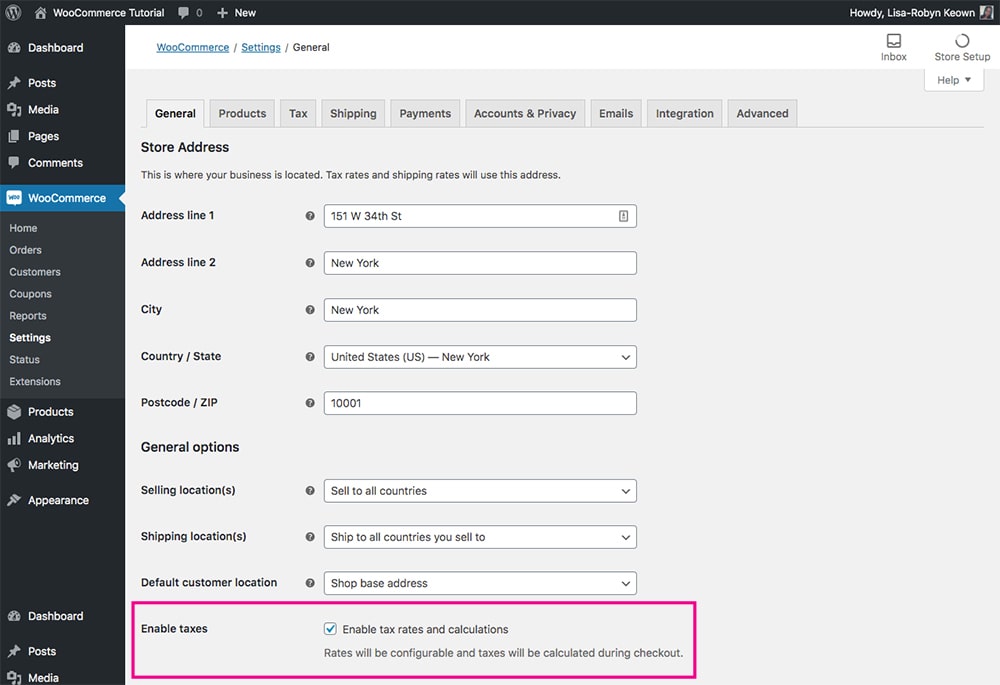
A new tab named Tax will appear once you’ve enabled taxes.
Step 2: Navigate the WooCommerce Tax tab
Now, you need to open the Tax tab. There are four menus: Tax options, Standard rates, Reduced rate rates, Zero rate rates.
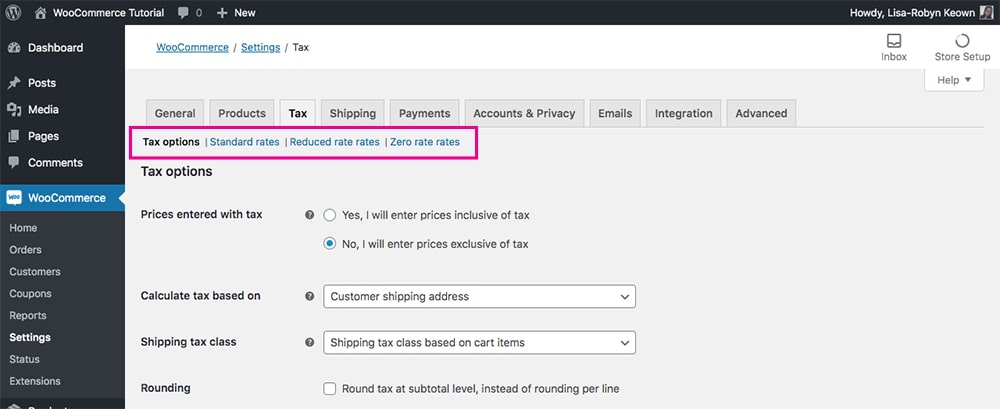
The following options are available in the Tax Options menu:
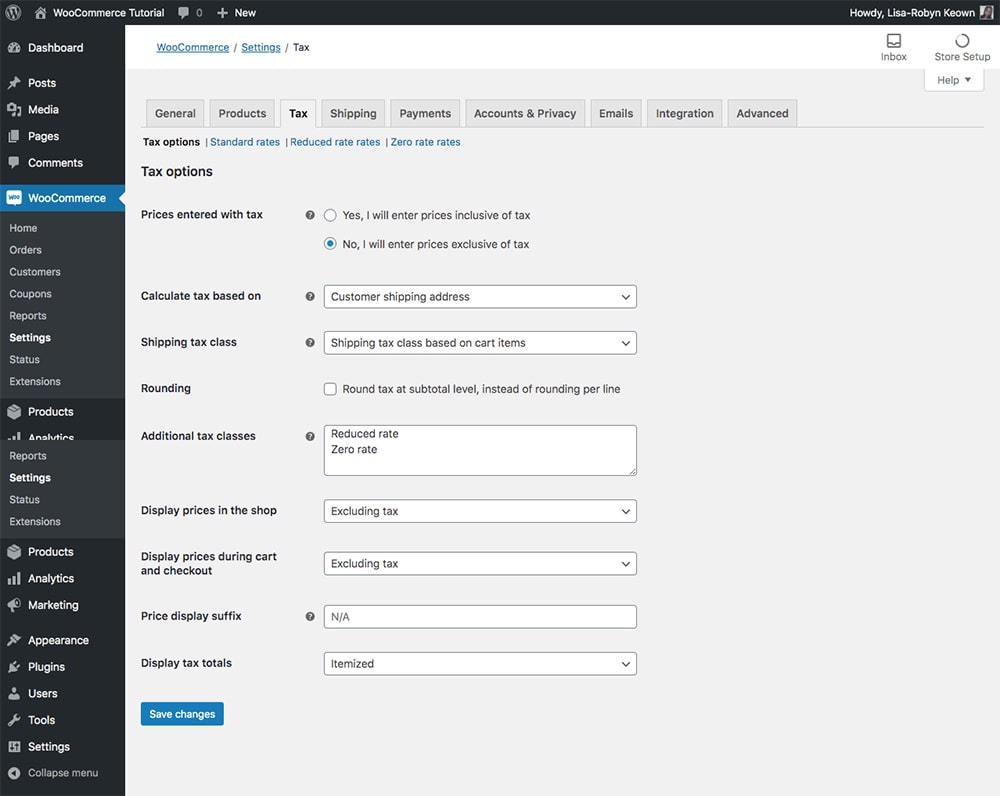
-
To begin, you must select whether your product prices will be tax-inclusive or tax-exclusive.
-
If you choose the first option, Yes, I will enter prices inclusive of tax, you will be able to calculate prices that include the store’s tax rate. For example, if a certain area has a tax rate, this rate will apply to purchases made within this location. The tax rate will not be applied to purchases made outside of the store.
-
When you choose the second option, No, I will enter prices exclusive of tax, prices will be entered without tax. Tax will be included as an extra fee and will be provided at the time of checkout. For example, if you sell a product for $10 in your store, the total cost at checkout will be $12 (plus a $2 tax fee).
-
-
Calculate tax based on: A drop-down menu is the next option. It provides you with three alternatives and allows you to choose which location you want to utilize to fill out your tax form. You can select from the following options: Customer shipping address; Customer billing address; Shop base address.
-
Shipping tax class: The shipping tax class must be defined next. The shipping tax class is usually determined by the products in the cart. If a consumer adds a product to their cart that is subject to a different tax rate, the shipping tax will be computed at the same rate as well.
-
Shipping tax class based on cart items is the most popular choice; however, if this is not how your store runs, you could pick another Shipping tax class from the drop-down menu, such as Standard, Reduced rate, or zero rates. There is a lengthy section on shipping prices and classifications following; if this does not make complete sense at this time, please wait until the next part.
-
Rounding: You will now be asked for rounding. This option requests that you round the taxes to the nearest estimated digit on the subtotal or for each line item or product.
-
Additional tax classes: WooCommerce not only provides a few basic tax rates but also allows you to create your own. You can do it here in the Additional Tax Classes section if necessary. When you establish a new tax class, it will appear in the Tax menu items as a new choice.
-
Display prices in the shop: You could choose whether you want your product prices to show in the shop with or without the tax rate.
Display prices during cart and checkout: You can choose whether you want your product prices to show with or without the tax rate within the Shop.
-
Price display suffix: This is where you can add a suffix to the end of the product price. For example, you may include wording like “inclusive of VAT” or something similar.
-
Display tax totals: The last option allows you to specify whether the final tax balance should be displayed as a single total or itemized. When you choose to display a single total, the taxes payable on the sum of the goods in the cart are displayed, whereas itemized displays the tax due for each item.
When you complete updating the settings, remember to click the button Save changes.
Step 3: Set the tax rates
After you’ve set up your online store’s tax options, it’s time to determine the tax rates. This can be accomplished through the use of the menu’s tabs. There are three tabs to choose from:
- Standard rates, you can configure alternative tax rates for your store here.
- Reduced rate rates, under this section, you can configure tax rates for reduced rate products.
- Zero rate rates, tax-free products can be created here.
It is worth noting that you are supposed to calculate and enter the accurate rates for your store, as well as the rates for each place to which you are shipping.
If your items are distributed internationally and there are different tax rates in different countries, for instance, you may also want to set a standard rate and a reduced rate based on the intricacy of your store’s operation.
All of the different tax rates you’ve set up will appear as separate tabs here. You can build different tables by going to one of the rates. If you click the Standard rate, for example, you’ll see the various tax rates you’ve set up in numerous rows. According to your preferences, you can add or delete rows.
The standard tax rate field is left blank by default. To begin, select Insert Row from the drop-down menu.
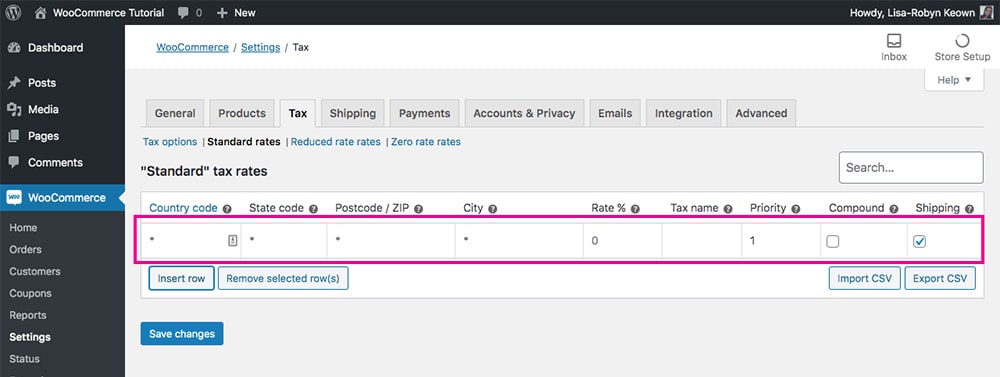
You will now see an additional row where you can define the tax rate. You can begin inputting the necessary information by following the steps outlined below:
-
Country code: A two-digit country code must be specified. All of the officially allocated nations’ ISO 3166-1 alpha-2 codes may be found here . You can leave this blank if you don’t want to pick a particular nation.
-
State code: Similar to the country code, the two-digit codes for states must be entered wherever they apply. You can also leave this field blank if you don’t wish to designate a particular state.
-
Zip/ Post code: This field is for the tax region zip/ post code. You can enter zip codes for a particular region in a variety of ways. When inputting several zip codes, a semicolon can be used to separate them. For post codes, this field also accepts wildcards and numeric ranges. You may include ‘90*’ to apply the tax rates to all zip codes beginning with 90, for example. Similarly, you could specify a range, such as 90001…90009, to apply the tax rate to all zip codes in that range.
-
City: After that, you must indicate which city or cities this tax rate applies to. Multiple cities can be selected, separated by a semicolon. You can leave the box blank to apply the rate to all cities within a nation or state, just as in the previous situations.
-
Rate: This is where you set the relevant tax rate to the fourth decimal point. For example, if you want to establish a tax rate of 10%, enter 10.0000, and if you want a rate of 12.5%, enter 12.5000.
-
Name: You can also give the tax rate a name. For instance, Sales Tax, VAT, etc.
-
Priority: For the tax rate, you can also choose a priority. Only one matching rate per priority has been specified. If you’re establishing several tax rates for the same location, you’ll need to give each one a distinct priority.
-
Compound taxes: Tick this box if you want the rate you’re defining to be applied on top of all other taxes. Assume you have an extra tax on top of the standard sales tax in a certain jurisdiction. The compound tax option controls whether the additional charge is based only on the product price or includes both the product price and the standard sales tax.
-
Shipping: You must also tick this option if you want this tax rate to apply to shipping expenses. When you select this box, the tax rate will be added to the product price as well as the delivery costs. When this box is unchecked, the tax rate is calculated solely on the product price. You can save adjustments to the tax rate that will apply to consumers from that specific region once you’ve entered all of the appropriate numbers in all fields.
Depending on the type of your shop, product, and the areas to which you ship, you can add numerous tax rates. It’s important to note that we are neither tax nor trade experts, and these are just for demonstration purposes. Therefore, if you’re unclear about your store’s tax rules, please get advice from an expert.
5 Best WooCommerce Sales Tax Plugins
In this part, we’ll introduce you to the five best WooCommerce sales tax plugins.
1. TaxJar for WooCommerce
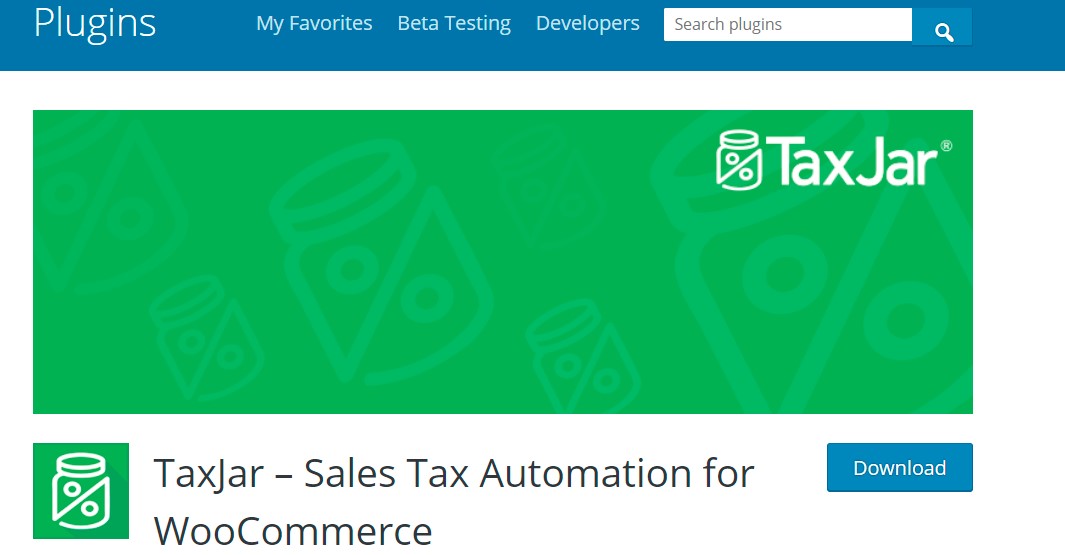
TaxJar for WooCommerce handles all of your sales tax requirements. The plugin uses your store address, your customer’s address, and other details such as line items and shipping at the cart and checkout page to calculate accurate sales tax (including state, county, city, and special taxes) based on your store address, any nexus locations stored in your TaxJar account, local sales tax sourcing laws, shipping taxability laws, itemized discounts for coupons, and sales tax sourcing laws.
Features:
- Seamless and Automatic Filing
- Return-Ready, Jurisdiction-Level Reporting.
- Real-time Sales Tax Rates & Calculations
- Economic Nexus Insights.
- Award-Winning support.
- Simple onboarding
Pricing: Order-based pricing. No setup fees, connector fees, or service filing fees.
2. Quaderno
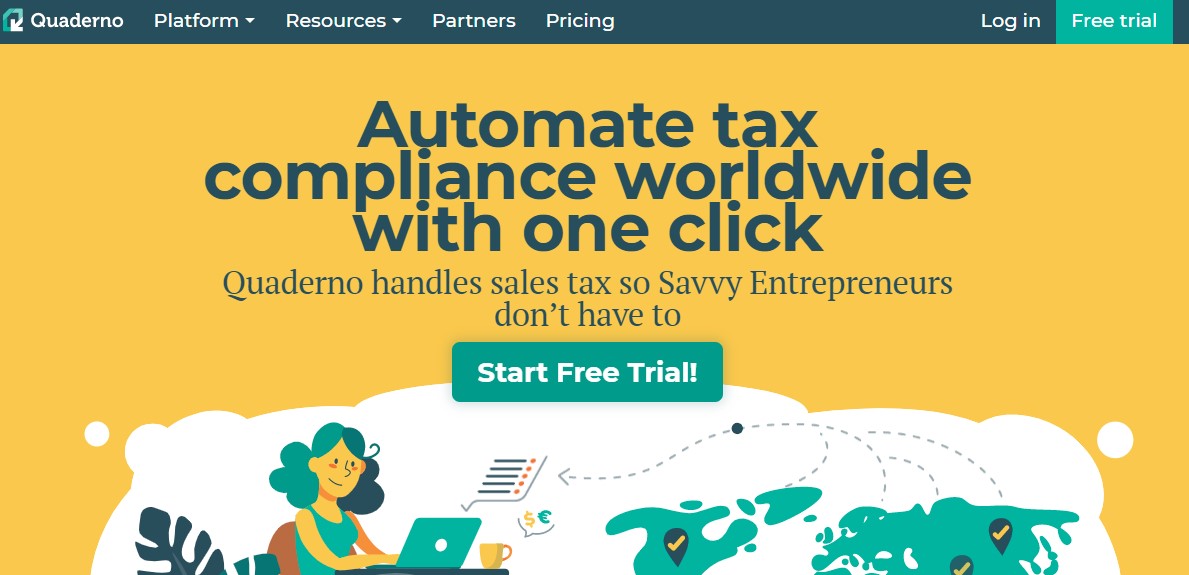
Quaderno is a robust and versatile digital platform that effortlessly interacts with your systems to automate the whole sales tax process. Thousands of SaaS firms, e-commerce entrepreneurs, and digital content creators rely on Quaderno to simplify tax management and help them expand their businesses online.
Features:
- Automating tax compliance forever with only one click
- Calculating the appropriate sales tax rate on every transaction
- Keeping a close eye on the metrics that matter
- Using instant tax reports to file returns in minutes
- Automating receipts for all transactions worldwide.
- Creating a bespoke dashboard for each customer
Pricing: Transaction-based pricing
3. Sovos Taxify
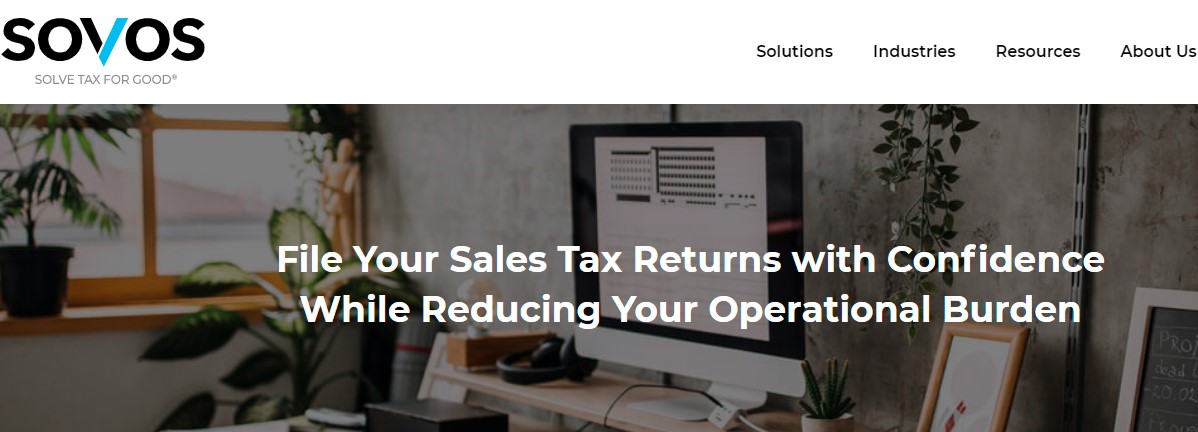
Taxify specializes in making it simple for online merchants and small businesses to compute taxes properly, minimize tax gaps, and file state and local tax forms automatically. It offers a comprehensive solution to small and medium-sized enterprises’ sales tax reporting problems. Sovos Taxify has worked with a variety of companies, from startups selling stock on Amazon to manufacturers wanting to grow into new markets to omnichannel sellers using numerous POS, e-commerce, and marketplace channels.
Features:
- Custom APIs and Ready-to-Connect Integrations
- Tax Rates in real-time
- Paper and eFile Tax Forms that are ready to file
- Remittance and filing automation
- Streamlined Sales Tax Project Member
- Reporting & Audit Trail
Pricing: Taxify’s monthly price starts at $47.00 per user. There is no free version available but Taxify provides a risk-free trial.
4. Avalara AvaTax
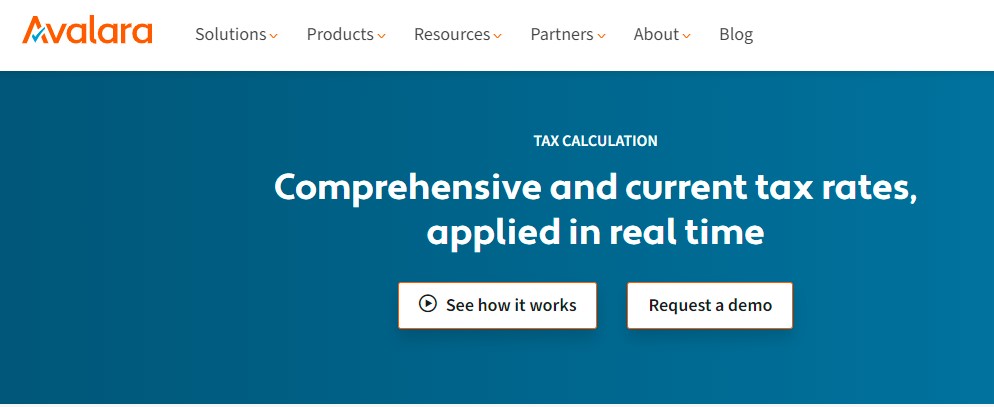
Avalara AvaTax is a cloud-based solution for calculating sales and use taxes. Without bogging down your IT or finance staff, AvaTax calculates sales tax for each of your company transactions depending on jurisdiction laws and norms. It maintains track of rate changes at each address and applies different tax rates automatically. It also works for firms of all kinds, from small to medium to large enterprises.
Features:
- Omnichannel-ready
- Cloud-based service
- Address validation
- Advanced transaction rules
- Pre-built Integrations
- Sales Tax Exemption Management
- Returns Reporting
- Product taxability
- Custom Tax Rules
- Sourcing rules
- Centralized tax management
- Standard Reporting
- Geolocation Technology
Pricing: There is no free trial for AvaTax and its pricing plan starts at $50 per year.
5. Simple Sales Tax by TaxCloud
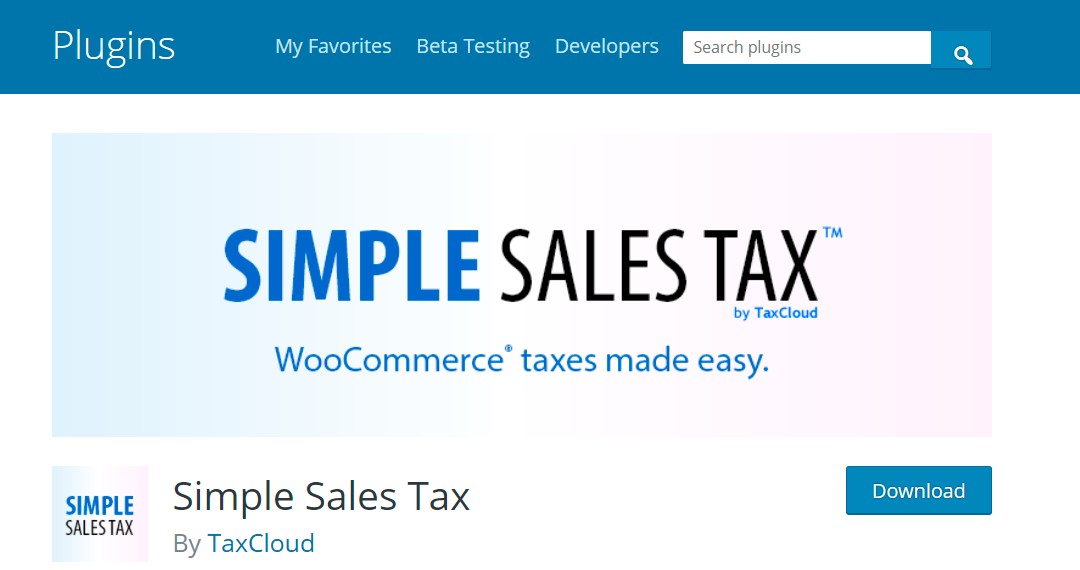
Simple Sales Tax automates sales tax calculations, reporting, and filing by integrating your WooCommerce store with TaxCloud. Simple Sales Tax is the most powerful and cost-effective sales tax automation solution for WooCommerce, with low service costs and built-in support for product-level tax exemptions and tax-exempt customers.
Features:
- Affordable with competitive pricing plans
- Accurate sales tax calculations
- Advanced reports
- Exemption certificates
- Product level exemptions
- Recurring payments
- Multi-destination shipments
Pricing: TaxCloud’s monthly price starts at $9.00 per feature. There is a free version as well as a free trial.
Final words
Managing sales tax on your WooCommerce store is a complicated procedure that costs you a lot of time and energy. But hopefully, our detailed instructions on how to set up WooCommerce sales tax for your online store helps you in the challenging process.
If you have any questions, please feel free to reach out to us via the comment section below.
Thank you for reading and we’ll see you in the next article.





